

Pracht en Kracht Kromme Rijnstreek. Ruta per les botigues centenàries que desafien el pas del temps. El petit comerç tradicional del centre de Barcelona abaixa la persiana. "88 anys després de la seva obertura i després de 82 d'activitat a la Ronda de Sant Pere 3.
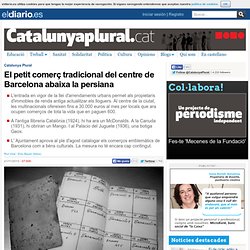
El Fòrum, diez años después. En la planta 23 del hotel Princess hay un bar de aspecto ibicenco.
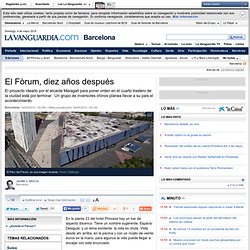
Tiene un nombre sugerente, Espacio Desigual, y un lema excitante: la vida es chula. Vista desde ahí arriba, en la piscina y con un mojito de veinte euros en la mano, para algunos la vida puede llegar a encajar con este enunciado. Mirando hacia el mar, todo lo que se ve desde aquí, sesenta metros por debajo del mojito, no existía antes del 2004. Es el Fòrum, el lugar construido para albergar el Fòrum de les Cultures del año 2004. El día 8 se cumplirán diez años de la magna inauguración que presidió el Rey. En este lugar, antes de aquella fecha había algo así como la nada. En términos urbanos, la gracia de este acontecimiento consistió en que la depuradora, la incineradora y las centrales térmicas siguen estando ahí, pero hay muchas más cosas. 1.985 millones de euros en cosas.
Aquel modelo disparó la renta familiar, y de qué modo, en primera línea de mar. (1) Creativity and tourism in the city. Its aesthetic or historic perfection, the more difficult it will be to extend the product.‘ This points to the problem that the more attractive cities become as tourism destinations and themore experienced tourists become in consuming the experience of urbanity, the more difficultit is for cities to distinguish themselves in an increasingly crowded marketplace.The advent of the experience economy (Schulze, 1992; Pine & Gilmore, 1998) strengthenedthe reproduction of urban cultures, and stimulated the development of a plethora of newattractions and events in cities, including many iconic buildings and mega events (Roche, 1992; Hall, 1994).
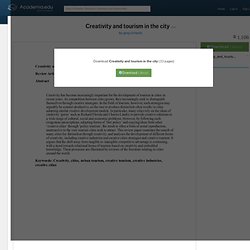
In world cities ‗the accumulation of an urban based knowledge economy has meant cities have become the point where knowledge is transformed into productive. Barcelona House. Zakir Maqsood. Creative Cities, Creative Spaces and Urban Policy. The paper presents the results of an international study of creative industry policies and strategies, based on a survey of public-sector creative city initiatives and plans and their underlying rationales.
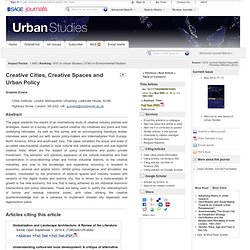
As well as this survey and an accompanying literature review, interviews were carried out with senior policy-makers and intermediaries from Europe, North America, Africa and south-east Asia. The paper considers the scope and scale of so-called new-industrial clusters in local cultural and creative quarters and sub-regional creative hubs, which are the subject of policy interventions and public—private investment. International Creative Tourism Associates. Amsterdam — Creative Metropoles. Amsterdam is the capital of the Netherlands.
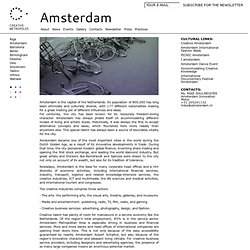
Its population of 800,000 has long been ethnically and culturally diverse, with 177 different nationalities making for a great melting pot of different influences and ideas. For centuries, the city has been known for its resolutely freedom-loving character. Amsterdam has always prided itself on accommodating different modes of living and artistic styles. Historically, it was always the first to accept alternative concepts and ideas, which flourished here more readily than anywhere else.
This special talent has always been a source of boundless vitality for the city. Amsterdam became one of the most important cities in the world during the Dutch Golden Age, as a result of its innovative developments in trade. The creative industries comprise three sectors: Creative Industries. Pla Estratègic de Turisme de Barcelona 2015. Carta de Turismo Responsable Biosphere World Class DestinationCertificación como destino turístico responsable Global Sustainable Tourism Council (GSTC)
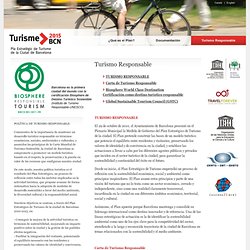
POLICIES FOR SUSTAINABLE DEVELOPMENT. Has Tourism Ruined Barcelona? My friend posted a video to Facebook from BBC’s Fast Track, questioning whether Barcelona has been spoiled by tourism.
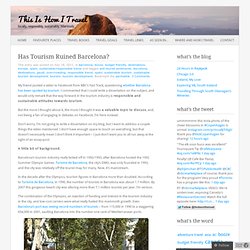
I commented that I could write a dissertation on the subject, and would only remark that the way forward in the tourism industry is responsible and sustainable attitudes towards tourism. But the more I thought about it, the more I thought it was a valuable topic to discuss, and, not being a fan of engaging in debates on Facebook, I’m here instead. Don’t worry, I’m not going to write a dissertation on my blog, but I want to address a couple things the video mentioned. I don’t have enough space to touch on everything, but that doesn’t necessarily mean I don’t think it important – I just don’t want you to all run away at the sight of an essay-post. A little bit of background. N INCOMING WORKSHOP - SIW 2014. 09669582.2012.751717. RSUS_A_531938_O - 09669582.2010.531938.
Activities - Cittaslow International - www.cittaslow.org. Slow tourism network. The partners in the SLOWTOURISM strategic project, which is co-financed within the scope of the Cross-border Cooperation Operational Programme Italy - Slovenia 2007-2013 from the funds for regional development and national funds, have prepared a diverse tourist offer.

Slow living in a city environment. Turkish fast food: Real food fast The definition of fast food according to the Wikipedia is food cooked in build and in advance, kept warm or re-heated to order....
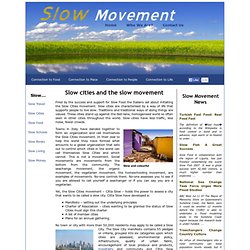
Slow Fish a great success Slow Food in collaboration with the region of Liguria, has just finished celebr4ating the event Slow Fish 2007. It was a great success with 42,000 visitors, a much higher number than expected. ... National Sea Change Task Force urges more flood studies ABC Wed Jul 11 07 The Mayor of Maroochy Shire on Queensland's Sunshine Coast, Joe Natoli, says it could be another 12 months before the CSIRO is able to undertake a flood modelling study in the Sunshine Coast region because the research body is under-funded. ... Treechangers change country culture An influx of treechangers into a rural community can keep population levels steady but it can change the needs and expectations within the community. ...